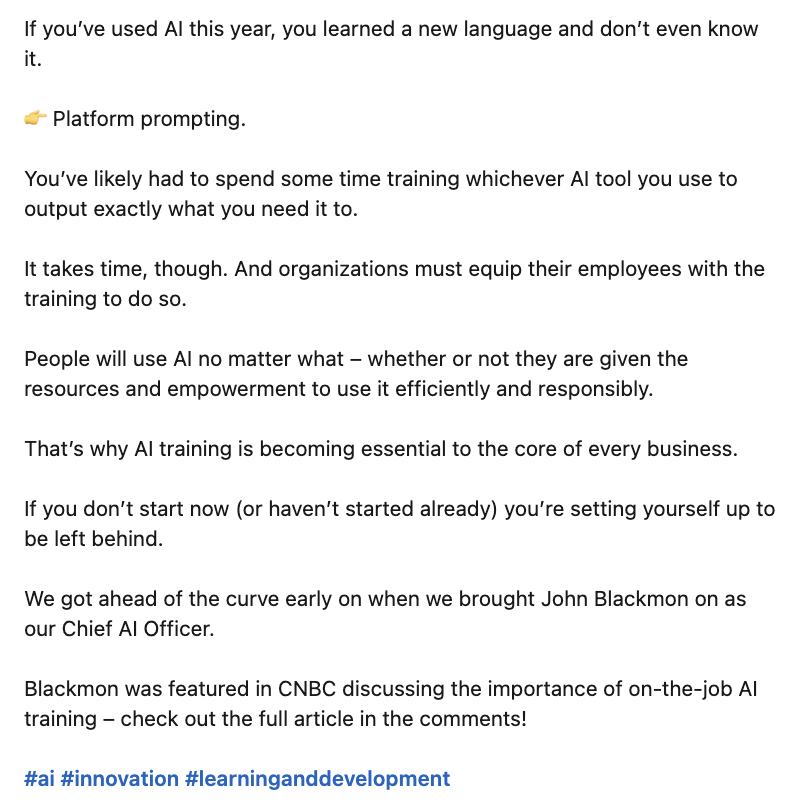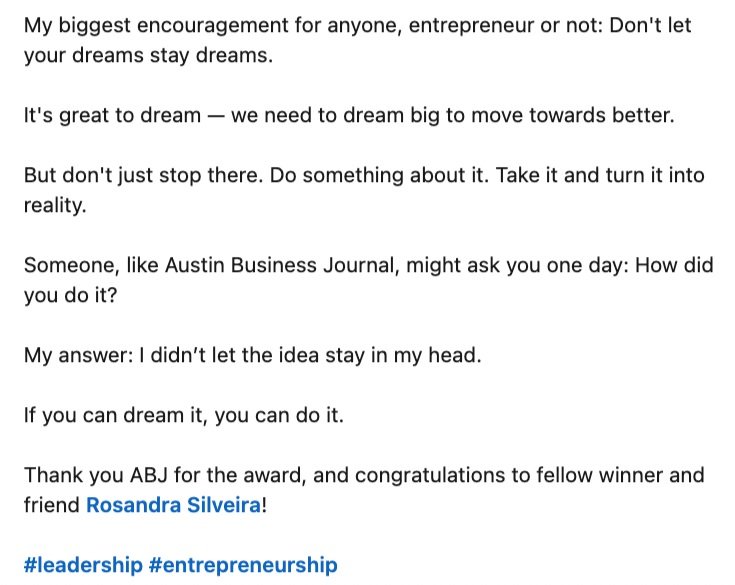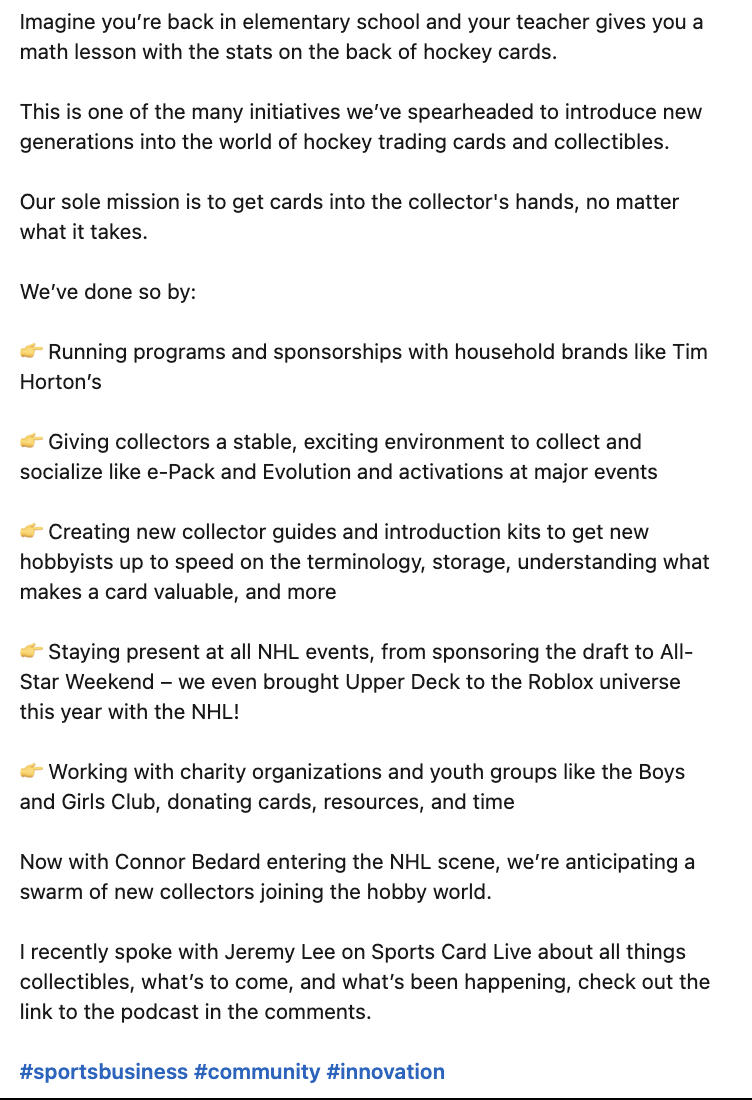Four Ways PR and Content Lift Each Other Up
Published February 22, 2024
The other day, an editor at a digital tech magazine reached out to us. She wanted contributions from women tech leaders sharing fresh perspectives on what working in the industry is like today.
She wasn’t looking for another “how women can support other women in the workplace” story; instead, she wanted the “wow factor.”
Luckily, we have a wow factor engine for many of our executive communications clients. It might surprise you, but it’s their LinkedIn feed.
Well, it’s not really the feed itself; it’s the consistent process we’ve built to get personal POVs on the feed. It’s content that builds authority and relatability, which leads to trust. That trust builds with current, past, and potential partners, clients, employees, and investors. It also builds trust with the media.
In this instance, we tapped into one client's editorial history and landed on a topic that had overperformed on LinkedIn about why being a “kind” leader is preferable to being a “nice” one. The editor quickly said yes to the idea and that’s another contributed article in the books.
The process was turnkey.
I’ve led PR and content marketing teams ranging from in-house at big media brands to boutique PR agencies and have learned that, like this example, content and PR can lift each other up. I’ve also seen a lot of missed opportunities to make that happen.
Here are the different opportunities to unlock:
Consistent Subject Matter Expert Conversations Drive Sustainable PR Content
From a content perspective, we make it a point to set up a dedicated time with an executive sponsor – apart from regular meetings with our day-to-day contact. Many times that’s the founder, but it has been the Chief Business Officer and the Chief Tech Officer, too.
We look for subject matter experts who are well-connected within the industries we’re trying to influence and have a deep interest in the company “winning.”
In-house comms teams should consider the same tactic. We lean toward hosting these meetings once per month. Find the consistency that doesn’t overextend the exec and allows you to keep a constant flow of POV.
Make this meeting separate from any tied to a specific project; it’s not to plan the sales kick-off or customer conference. The time should be firmly used to allow space to think and develop ideas. Your goals are to walk away with ideas that can:
Fuel upcoming owned content
Drive media pitch angles
I’ve written in the past about how to prepare for these meetings and the kinds of questions to ask. The biggest tip is to think like a reporter, not a company spokesperson. We’ve also written about how to spot opportunities and story ideas from these conversations.
Pro Tip: Clients always ask us: “Do I need to prep for this interview?” We always answer: “It’s better if you don’t.” You want to get their off-the-cuff expertise. In this case, authentic is better than perfect. You can always help them perfect the communication of their ideas afterward.
If it comes together as it should, you’ll create your own “wow factor” engine that services PR, content marketing, sales, and more:
You nail the executive’s voice so ghostwriting becomes easier.
You get reactions tied to trending or timely news so newsjacking and capitalizing on seasonal hooks become turnkey.
You get the stories behind the stories – what was the behind-the-scenes story of building the product or company, what “failures” led to today’s successes – to add color to your storytelling.
You understand the top-down business goals and culture, which helps to prioritize tactics, targets, and more.
You set yourself up for a successful Sustainable PR (and content marketing) strategy throughout the year.
Consistent Content Means You Have “Proof” of Interest and POV
When the content engine is running and you put your ideas and thoughts out into the world, pay attention to what the world tells you back. There’s a good chance that what you hear from users, readers, and followers will spark an idea on the media side.
The over-performing “nice vs. kind” LinkedIn post that turned into a byline is one example. Here are a few other ways we often see this playing out.
Google Analytics shows that CES content overperforms for us, so we include pitching Carve as experts on breaking through the noise at the event alongside all the CES work we do on behalf of clients. Here’s one resulting story in Lifewire featuring our CEO.
We collaborated with a client on a conference speaking engagement tied to Scaling Culture as a Company Grows. That turned into a Fast Company byline.
We posted about one serial entrepreneur’s product launch “failures” in between his successes. It was a popular topic that got others sharing about their learnings from “failure.” That turned into a podcast interview with Extrology.
More than anything, a consistent and engaging POV – whether that’s via a LinkedIn feed, a newsletter, or an entirely new channel – sets your brand and executive apart. Media like to know your proposed spokesperson will be a valuable resource and not a parrot spewing corporate messages.
Consistent Media Coverage Means You Can Fill in the Blanks on PR and Content Ideas
I started my career in PR so I appreciate the work that goes into a placement. We even started a How’d You Get That Hit video series to celebrate some of those big wins and shed light on the behind-the-scenes.
But beyond just PR fangirling, I love a good hit because it gives the content side more to play with.
Here’s the catch: Don’t post the self-promotional “we were featured in Fortune about how to get your estate plans in order. Read it below!”
People may give you a thumbs up, but how many beyond your mother will read it? And is your goal to get them to read the piece or to get them to understand the news or ideas in the piece that position your brand or exec as an ideal partner?
I’d think the latter.
Instead, pull an idea from the coverage right into your post – something your audience would find intriguing and may generate conversation. Choose something that makes for better PR content than just a link. Below are three examples promoting the ideas found within hits in CNBC, Sports Card Live, and Austin Business Journal.
SparkToro’s Amanda Natividad dubbed this idea of putting the value in the post itself “Zero-Click Content.” It’s an article we’ve shared again and again because it speaks the truth.
We’ve also dubbed some pieces of media coverage the “gifts that keep on giving” because they’re so loaded with ideas that we turn to them again and again for PR and content marketing.
Ross Simmonds is famous for saying, “Create once, distribute forever.” “Secure one piece of coverage, distribute it forever,” works, too. (Thank you to our PR colleagues.)
Consistent Media Monitoring Means There’s Always Something to Opine About
I’d imagine most comms people have a soft spot in their heart for media monitoring. (Or is that just me?). It’s about knowing what’s going on in the world but, more specifically, knowing that opportunity is just around the corner.
A comms person’s brain is always ticking with: “Is this the news piece that we can connect our client or brand to?”
So, make sure you have a repeatable media monitoring plan in place where everyone understands their roles and responsibilities. Move quickly when the news warrants pitching the media; trendjacking is one instance where speed beats all else. The good news is because you’re already regularly in touch with the subject matter expert, turning around a POV quickly shouldn’t be an issue.
Pro Tip: Consider different approaches to media monitoring. On our end, some clients ask for a daily industry take; others prefer flags as they happen. Many tools can help streamline this but you really need the human touch to flag why the news matters, build out the response, and go after a precisely targeted list.
And then, guess what? Take that hot topic to your next subject matter expert meeting and build out that POV even further.
Did we just come full circle? I think we did.






